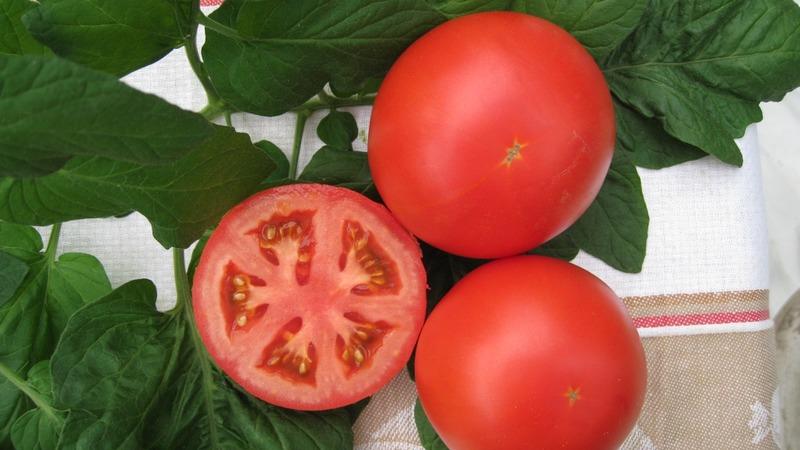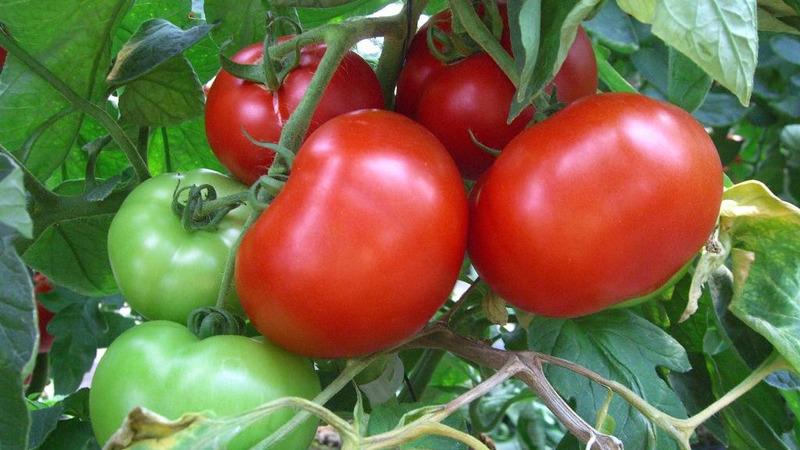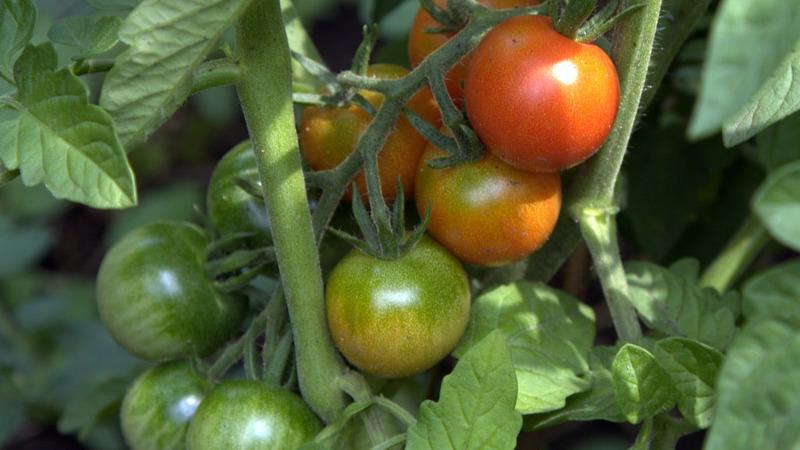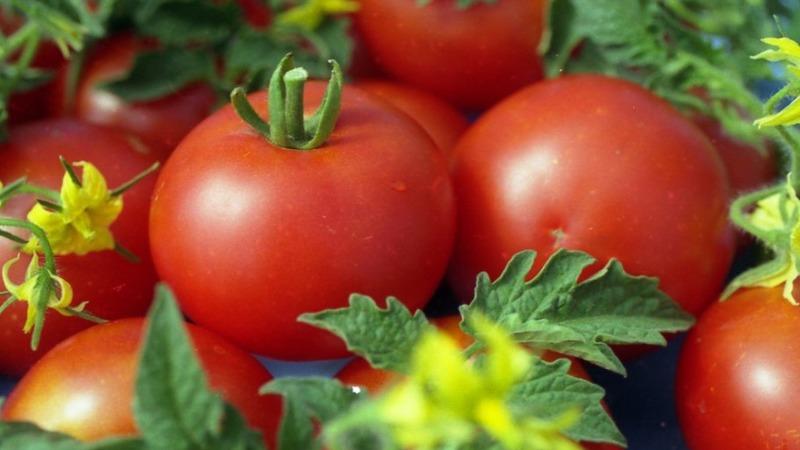A unique early ripening tomato "Anyuta", which makes it possible to get a double harvest
The ability to produce crops in small summer cottages and large farms makes Anyuta tomatoes very popular in Russia. But of course, these are not all the advantages of the variety. The characteristic of Anyuta tomato is complemented by: double yield, ease of care, favorable reviews of gardeners.
The early ripe hybrid that has taken root in the southern beds does not cease to delight both beginners and professionals of the gardening world with delicious tomatoes.
The content of the article
Characteristics and description of the tomato variety Anyuta
The hybrid tomato variety Anyuta belongs to the determinant type. The height of the bushes reaches no more than 70 cm. The bushes have a large number of green leaves. A powerful stem makes it possible to do without a garter of a low-growing plant, but numerous reviews of the tomato variety Anyuta F1 advise not to ignore this moment: without a garter, the bushes lie on the ground under the weight of ripe vegetables.
The variety was bred in Russia... Differs in unique early maturity: from sowing seeds to ripening of fruits, it takes 85-95 days. This factor gives an advantage: gardeners harvest twice a season. The first harvest begins at the end of June, and by mid-August the second wave of tomatoes ripens. Under favorable weather conditions, fruiting continues until mid-September.
Resistance to late blight is average, but the variety is practically not affected by tobacco mosaic and top rot.
Fruits are round in shape, slightly flattened on top, not prone to cracking. The average weight of a vegetable is 90 - 120 g. The color is red, pronounced, which is clearly visible in the photograph.
Ripe vegetables are generally recommended for fresh use. But re-collection is successfully used for winter harvesting.
The average yield of one bush is 2.5 kg, provided that 6-7 plants are planted per 1 sq. m.
Fruits differ in keeping quality during long-term storage and withstand long transportation.

How to grow seedlings
Sowing of seeds begins in the last decade of March. But the specific time frame affects the climatic features of the region.
Before planting, the seeds are determined for suitability by placing them in a saline solution. To do this, dissolve 1 teaspoon of salt in a glass of water. Floated seeds are not suitable for sowing. The rest are washed well in clean water. Soaking seeds in a growth promoter increases germination. For germination of the grains, they are placed in a damp cloth for 1-3 days.
Reference! Seeds for planting next year should not be selected from the hybrid variety yourself. It won't give any result. Purchase planting material in specialized stores.
After the first shoots appear, the seeds are planted in prepared soil. A mixture of peat and humus in a 2: 1 ratio is suitable. You can sow seeds in wooden boxes, plastic glasses, peat pots. The containers are filled with a thin layer of drainage from small pebbles or wood chips and soil.
The earth is moistened and grains germinated in a damp cloth are laid in shallow (up to 2 cm) holes. After sowing, the ground is leveled from above and watered with water with the addition of growth stimulants. Then the containers are covered with plastic wrap.
The containers remain in a lighted room, where the air temperature is at least + 23C. When seedlings appear, the film is removed and complex fertilizers are applied.
The picking of seedlings is carried out after the appearance of three true leaves. If a seed sown in individual containers, picking is not required.
2 weeks before planting young bushes in open ground, the seedlings begin to harden. The hardening process is reduced to staying seedlings in the open air for a certain time: from 1-2 hours to 1 day. At night, the seedlings are removed to a room where the air temperature is no more than + 13C.
Advice! Before planting tomatoes in the garden, young plants must withstand being outdoors for at least 14 hours
How to grow tomatoes
A plot of land for a permanent place of tomatoes is prepared in advance. In autumn, the soil is dug up and fertilized, in the spring it is loosened and weeds are removed.
Sprouts are planted in open ground in mid-May in the evening or on a cloudy day. The plant will take root in the greenhouse in early May. The main condition: the air temperature at night should be kept at around +15. By the time the seedlings are transplanted, they already have a powerful stem, the height of which is at least 25 cm.
Tomatoes are planted on the beds in a checkerboard pattern with a distance of 35 cm between bushes in a row. The row spacing is 65 cm. A few days before transplanting, nitrogen fertilizers are applied to the soil.
The first watering spend three days after planting.
Reference! It is watered strictly at the root, without spraying drops of water on the soil surface, to avoid shedding flowers and fungal infections.
Before the first ovaries appear, it is sufficient to keep the soil moist. As soon as the fruits begin to gain weight and color, the volume of watering is increased. But it is not necessary to allow waterlogging of the soil, this will affect the taste of vegetables and is fraught with cracking of the fruit.
After watering, the soil is loosened, the bushes are heaped up and the weeds and roots are removed. For better moisture retention, resort to mulching beds with sawdust or peat. Mulching also promotes better root development.
The first feeding is carried out after 3 weeks. Use nitrophosphate and liquid fertilizer "Ideal": 1 tablespoon each for 10 liters of water. Under each caste, pour 0.5 liters of solution.
The first flower brushes require a new dose of fertilizer. Here “Senior Tomato” (1 tablespoon per 10 liters of water) is well suited. For one bush, 1 liter is enough. After the next three weeks, a superphosphate solution is used (1 tablespoon per 10 liters of water).
Organics are good as fertilizers, for example, bird droppings or infusion of weeds. Concentrate ratio 1:15 to avoid scalding of plant roots.
Reference! The application of organic fertilizers increases the number of ripe fruits.
With a weak development of the bushes, foliar feeding, for example, a urea solution, helps. The vegetable culture is sprayed with it, after dissolving 1 tablespoon of fertilizer in 5 liters of water.
According to the declared characteristics and numerous reviews, the tomato Anyuta F1 does not need pinching, but the opinions of gardeners differ about the garter. Experienced gardeners do not recommend neglecting the garter.

Diseases and pests
Average resistance of tomato culture to late blight obliges to know methods of prevention and control of this disease.
The affected parts of the plant are removed, followed by treatment with Bordeaux liquid, "Barrier", "Fitosporin". These drugs destroy the spore of the fungus - the cause of the infection. Copper sulfate is used for the prevention of diseases.
Reference! When the fruits ripen, it is recommended to use not chemical, but biological agents.
Plants are protected from harmful insects by covering the beds with wood ash or tobacco dust. Regular inspection of bushes for the presence pests Is also an effective method of prevention.
The nuances of growing in open ground and in a greenhouse
This variety is suitable for outdoor cultivation only in warm climates. A shaded area will not suit this culture, it needs a lot of light: a lack of lighting will affect fruiting.
To obtain the maximum number of fruits, farmers use an agricultural technique - growing on double roots. It takes its origin at the picking stage. Two sprouts are planted in one container with a distance of no more than 1 cm. After the seedlings take root, make small cuts on the sides with which they are directed towards each other, connect them and tie them with film. When transplanting seedlings into the ground, the weaker top is removed.

Harvesting and application of the crop
This early ripening variety bears fruit twice a season. The first vegetables are harvested from the end of June. The second collection falls in mid-August and in warm weather continues for another month.
Farmers in the double harvest saw material benefits and the variety was successfully used commercially. In addition, vegetables have a long shelf life, which allows them to be transported over long distances. The shelf life of fresh vegetables is up to 30 days.
In cooking, tomatoes look good in salads, perfectly complementing other vegetables. The autumn harvest is suitable for conservation, pickling, twisting. Other tomato products are also prepared: ketchups, juices, pastes - in winter such a solution looks good on any table.
And yet, the main merit of the culture is the long storage of fresh vegetables without loss of gastronomic properties.
Advantages and disadvantages
The tomato crop has enough positive characteristics to consider:
- early ripening;
- ease of care;
- does not require pinning;
- does not require an obligatory garter;
- the possibility of breeding without a greenhouse;
- fruiting crops twice per season;
- resistance to a number of diseases;
- good taste;
- excellent transportability;
- versatility in application.
There are much fewer negative sides:
- the survival rate of tomato only in the southern regions;
- average resistance to late blight;
- the need for sufficient lighting;
- does not tolerate excess and lack of moisture:
- only store seeds are suitable for sowing.

Farmers reviews
The opinions of amateur summer residents and professional farmers will acquaint you with this vegetable crop. Overall ratings are solidly high despite a number of characteristics of the variety.
The main role here is played by the ability of the culture to bear fruit twice per season, and the second harvest of fruits is not inferior to the first one either in quality or in quantity. A big plus to the harvested offspring adds versatility in application and commercial use.
Stepan, Taganrog: “I constantly plant an early-ripening hybrid, Anyuta, although I like to experiment with new tomatoes. But the proven one never deceived the offspring and did not get sick. And earlier ripening of vegetables allows adding vitamins to the table at the beginning of summer "
Svetlana, Kropotkin: “I was distrustful of early hybrids until I tried Anyuta F1. Tomatoes are tasty, aromatic, non-acidic. I spent a little time and effort on leaving. I am satisfied with the result ”.
Sergey, Moscow region:"My greenhouse small, but I want to plant a lot. Therefore, the compact hybrid was a godsend for me. Alarmed by the description that the culture for the southern regions. I tried to plant 4 bushes. The tomatoes ripened quickly, the care is minimal, the taste is at the proper level. I will plant much more next year. "
Conclusion
The early ripe hybrid Anyuta F1 has earned universal recognition and respect. Even those who planted this variety for the first time are delighted. Excellent taste of early ripe tomatoes and other characteristics of the variety do not leave gardeners indifferent. And the noble name Anyuta once again confirms the favorable reviews, because those who are not in love will not be called an affectionate name.